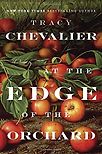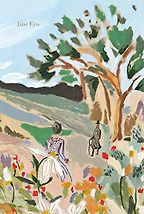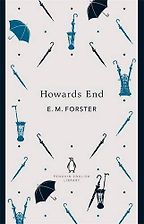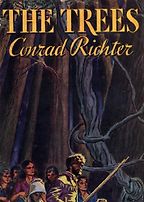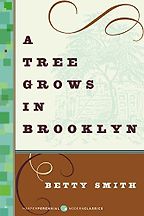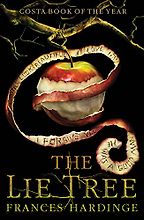Trees are central to your new book At the Edge of the Orchard—why?
People have such an emotional bond to trees. It’s very rare to find somebody who says, “I don’t like trees.” They go along with bread and chocolate, those staples of our lives that we can’t really do without.
As I started looking into the subject, I realised that although a tree stays in the same place all its life once it’s growing, trees as a whole move around. A tree doesn’t easily grow in the shade of its parent tree; the most successful tree children, you could say, are the ones that go a little further away. So trees move around when they propagate, and humans have moved them around too.
“I wonder if people who read a lot and touch pages a lot feel that extra-special connection to trees.”
For instance, we tend to think of the apple tree as native to England, but it’s not, it comes from Kazakhstan originally. Traders took apple trees down through Persia and Mesopotamia along the Silk Road, eventually reaching Europe, and then the Romans brought them to Britain. In America, we tend to think of apple trees as being native to the States, but in fact Puritan settlers brought them over from England.
There’s something that appealed to me about the contradiction between trees seemingly always being in one place and yet being moved around. It mirrors the movements humans make. I wanted to write about that.
You focus on two particular types of tree in your book – the Pitmaston Pineapple apple tree and Californian sequoias. Why these?
I chose two trees to represent two different parts of the journey made by the Goodenough family in the book. First, there are the apple trees, which were originally brought from England. Apple trees grow best when they’re not wild, but in a domestic setting, like an orchard. The apple trees are the roots of the family being transplanted and domesticated.
I chose the Pitmaston Pineapple because I wanted a tree that would be an unusual variety and old enough to have been brought over to the US in the 18th century. I looked through lots of varieties that I thought might manage to make the journey. I have no evidence of Pitmaston Pineapples actually being brought over, but I really liked the sound of them. I liked the name, I liked the fact that the apples are golden rather than green or red, and that they’re small. They’re an unusual shape and they have this unusual taste. James Goodenough has never tasted a pineapple but is told that’s what his favourite apples taste like.
“We tend to think of the apple tree as native to England, but it’s not, it comes from Kazakhstan.”
I also knew that Robert Goodenough—James Goodenough’s son—would be going west, and I’d been thinking about this grove of redwood trees growing on the border between Wales and England, along Offa’s Dyke, which I first saw 25 years ago. It was so odd to see the redwood trees growing there, and they stuck with me. They transmuted into sequoias when I started looking into why these redwoods would have come to England and discovered there was this whole Victorian craze for collecting conifers and plants from all over the world. I thought that the sequoia would be the tree which Robert would gravitate towards when he goes to California. It represents a wilder state, it’s not a domestic tree. It grows naturally in the wild, and yet it is domesticated when it’s taken to England.
You talk very eloquently about how trees move and how that echoes the movement of humans. What about those of us who are not so good at moving? I’m thinking of Sadie, James Goodenough’s wife, who is bent on destroying his orchard. She says that his trees are ‘doing better in the Black Swamp than I ever will’.
Sadie has very different feelings from her husband about trees, and that sums up their terrible relationship. This is a book about the American Dream and that idea of leaving behind your problems and going further west to look out for a new piece of land, or the freedom of the landscape which is going to unlock something for you and allow you to live more happily. I’m not sure if Sadie would have been happy anywhere, but it probably would have suited her to go further west. She says at one point that she wants to go to the prairie, where there are no trees at all. The physical freedom is what she’s looking for and the Black Swamp is the antithesis of that because the mud literally keeps you there—you can’t escape. And her husband pays so much attention to the trees in his orchard, rather than to her and the children, that it drives her crazy.
She fights with her husband all the time about ‘the spitters’ versus ‘the eaters’, tell us about that.
American children grew up hearing about the folk hero Johnny Appleseed. The story of Johnny Appleseed is all about eating apples—sweet apples—and how healthy they are. The reality was that Johnny Appleseed sold trees which primarily produced sour apples, and you could only use these for drinking, made into cider or ‘applejack’. So the sheer botany of how trees grow and what kind of fruit they produce undermines the myth.
This book started from a vision of a couple fighting over what kind of apples to grow. I just knew that one of them—and I decided it would be Sadie—wanted to drink her life away rather than eat sweet apples.
John Chapman, as Johnny Appleseed is known in your book, disagrees with grafting trees on religious grounds. How does religion tie in with trees and the way the settlers used them?
The real John Chapman believed that grafting was going against God’s nature, that you have to let God decide whether an apple is going to be sweet or sour. Further East, religion would have been more dominant, but there were hardly any churches in the Black Swamp; their religion came via big camp meetings where everyone used to gather. The meetings were usually held after the winter, when people had been cooped up for months, so they really let go. They became very fundamentalist-style places, and there was a lot of raucous behaviour. I’m sure I’m going to ruffle some feathers with this part of the book!
Moving on to your favourite fictional trees, the first you’ve chosen is the horse chestnut at Thornfield in Jane Eyre.
I couldn’t resist this. Rochester proposes to Jane there, and then the next night it’s split in half by lightning. It’s a heavy-handed symbol but it’s still incredibly satisfying. It’s not even that the tree is struck down and killed, it’s split in half. The idea of marriage is that two people are going to become one, but here you know—because of the mad woman in the attic—that it’s one thing about to be split in two.
At the end of the book, Rochester refers to himself as the ruined tree and he says, “What right would that ruin have to bid a budding woodbine to cover its decay with freshness?” He’s saying there’s always hope, that even when a tree is ruined, it can foster new life.
Yes, because trees often do do that. A tree seems dead and then something grows out of it. It works very well in this instance.
Next we have Howards End.
Mrs Wilcox tells Margaret Schlegel of a superstition about the wych elm which grows by her family home, Howards End. The village people have embedded pigs’ teeth in it, so that if you have a toothache, chewing the bark from the wych elm is supposed to cure it. Margaret and Mrs Wilcox bond over this, whereas Henry—Mrs Wilcox’s husband who later marries Margaret—is very dismissive of that sort of superstitious folk history. The tree, and the tales surrounding it, represents a more organic and rural way of looking at the world, while Henry is more urban and modern. The two clash and, in the end, when it all falls apart and Margaret has to prop Henry up because his son is going to prison for having knocked over and killed Leonard Bast, there’s a resurgence of an older way of thinking.
There’s a point where Henry talks about building a garage over the roots of the tree. It couldn’t be worse!
Perfect! There’s something very solid and important about that tree. And it’s in the film—you know a part of a book is good when they actually translate it into the film.
Your third book is called The Trees. It was written in 1940 and is the first of Conrad Richter’s The Awakening Land trilogy. Like your own novel, it’s set in Ohio.
It’s a really weird book in a wonderful way. It predates the beginning of At the Edge of the Orchard by about thirty or forty years—I read it as research for this book—and it’s about this family called the Lucketts. The family, with five or six children, moves into this heavily wooded part of Ohio to hack out a living there.
There’s a lot of detail about dealing with trees. The trees are so strong and permanent that in order to survive there, you have to uproot the trees and they’re constantly pushing their way back in. It was in this book that I began to understand how hard it is to uproot a tree. If you’re going to plant a field full of something, you have to clear the land first, and the trees do not want to give up their roots very easily. It’s hellish getting them up. You start to wonder why on earth this family has moved to this place when it’s so difficult.
Towards the end, one of the younger daughters disappears. She’s gone to bring the cows home, and she doesn’t come back. Her older sister Sayward’s theory is that the trees have taken her—they’ve snatched her and they’ve eaten her. It’s really spooky and strange, and also really well told, and unusually told too.
What you’re saying reminds me a bit of fairy tales. Long ago, if a child disappeared, they’d say the fairies took them.
Exactly, and the trees here take the place of the fairies. In reality, what probably happened is that Native Americans took her, but Sayward can’t quite cope with this, so she blames the trees instead.
Your next book is A Tree Grows in Brooklyn, by Betty Smith, which was published at a similar time to The Trees.
Yes, and it’s completely different. It’s about an Irish-American family living in Brooklyn at the beginning of the 20th century. It’s a poor family: the father is an alcoholic and never really works, and the mother works every hour there is. It’s about all the different things that happen to the family, the ups and downs—but mostly downs, as it gets worse and worse.
Again it’s slightly heavy-handed symbolism, but the tree in the book is a tree of heaven, which is a tree that’s seen as invasive. It’s also an immigrant; it’s also scrabbling to survive. People are always trying to get rid of it: they chop it down and they pull it up, yet from the chopped-down tree springs a new tree. They never can seem to get rid of it and it grows in the courtyard of the tenements where the family lives. At the end, the family falls apart and yet still survives, just as the tree continues to grow.
One of the reasons I put it on the list is A Tree Grows in Brooklyn is such a great title. It’s the best tree title ever.
Your final choice is The Lie Tree by Frances Hardinge. It’s a new book, which recently won the Costa Book of the Year Award. Tell us about this lie tree – it’s a very imaginative creation.
It is, it’s really surprising. The novel starts out as standard historical fiction. It’s set in the 19th century and is about a family. The father is a naturalist. He’s been run out of town because it’s revealed that he falsified the fossils he claims to have discovered. The story is told from the point of view of his fourteen-year-old daughter Faith, who’s very clever but—of course—being a girl, she isn’t allowed to study even though she wants to. The family move to an island called Vane to get away from the scandal. Or at least that’s what Faith thinks.
Get the weekly Five Books newsletter
She discovers that her father has brought a specimen with him, which he hides in a cave. Faith follows him and sees that it’s a tree in a pot, a really small one, maybe two feet high. The tree, she finds out, is a tree that feeds on lies. So if you tell it a lie that people believe, it grows a piece of fruit, and if you eat this fruit, you go through a hallucinatory experience and discover truth in your dreams. The story becomes incredibly gothic and strange. This tree grows and grows in the sea cave. It’s hard to get there by boat and the water comes up and cuts you off and you’re stuck in this cave in the dark. The tree doesn’t like light so you have to keep your lantern really dimly lit, and it grows to completely fill this space, and there are these snaking vines all over the place, and it grows like this over the course of just a week or so.
I don’t know how Frances Hardinge came up with this crazy idea that a tree would feed on lies. Nothing really prepares you for the book going so off-piste and that’s what I love about it—it’s really wild! I thought it was an incredibly creative way of using a tree.
It’s such a powerful idea: feeding a tree lies and then it fruiting the truth. Do you think Frances Hardinge is drawing a parallel with the tree of knowledge in the Garden of Eden?
Yes, definitely, and in the book there is speculation that it actually is the tree of knowledge, or came from the very first tree of knowledge. The whole thing about truth and lies refers all the way back to that.
It made me wonder if whenever you write about a tree—particularly an apple tree, like you’ve done—is there always an element of that original tree of knowledge in there?
Absolutely, and I knew that, but I tried very hard not to think about it too much when I was writing At the Edge of the Orchard. I thought otherwise the symbolism would become really heavy-handed and I’d use it in a way that would just irritate people. So I tried as much as I could to keep that to a minimum, but I know that readers will have it in their minds.
Would you say there’s a fundamental connection between trees and books? After all, books are made up of paper – they are essentially trees.
Yes, I’d never thought about it that way. I wonder if people who read a lot and touch pages a lot feel that extra-special connection to trees. I’ve noticed when talking to people about trees that most people’s relationship with them develops in childhood. I don’t know quite why, but I think it’s partly because when we’re young we climb them and we don’t tend to climb them as adults. There’s something when you’re actually touching it and sitting in it and hugging it and being there with it that makes you feel much more attached to a tree. Maybe the adult connection to trees is more indirect, and it’s through the pages of books.
Interview by Emily Rhodes
March 11, 2016. Updated: December 8, 2023
Five Books aims to keep its book recommendations and interviews up to date. If you are the interviewee and would like to update your choice of books (or even just what you say about them) please email us at [email protected]
Five Books interviews are expensive to produce. If you've enjoyed this interview, please support us by donating a small amount.

